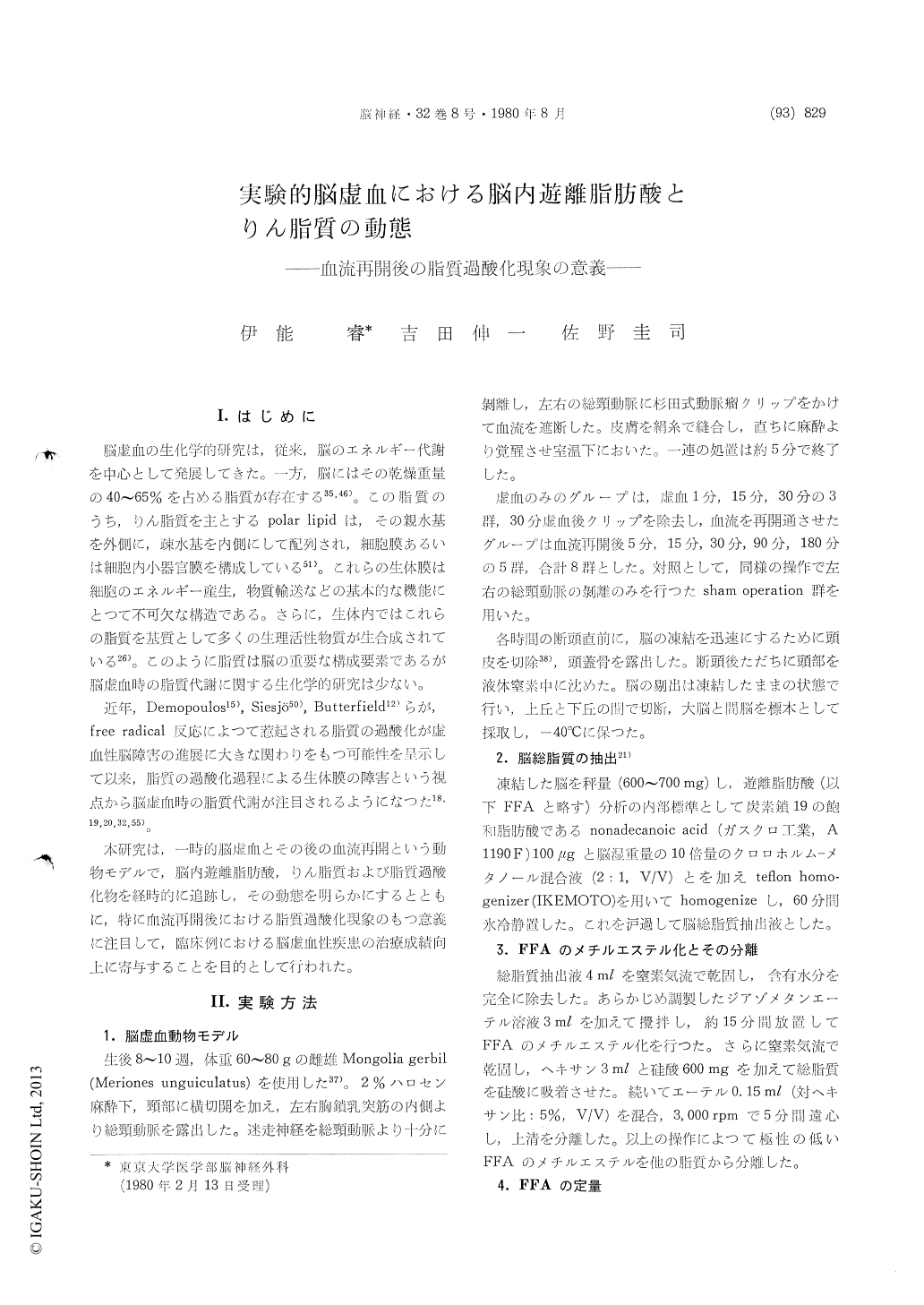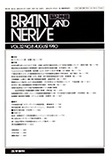Japanese
English
- 有料閲覧
- Abstract 文献概要
- 1ページ目 Look Inside
I.はじめに
脳虚血の生化学的研究は,従来,脳のエネルギー代謝を中心として発展してきた。一方,脳にはその乾燥重量の40〜65%を占める脂質が存在する35,46)。この脂質のうち,りん脂質を主とするpolar lipidは,その親水基を外側に,疎水基を内側にして配列され,細胞膜あるいは細胞内小器官膜を構成している51)。これらの生体膜は細胞のエネルギー産生,物質輸送などの基本的な機能にとつて不可欠な構造である。さらに,生体内ではこれらの脂質を基質として多くの生理活性物質が生合成されている26)。このように脂質は脳の重要な構成要素であるが脳虚血時の脂質代謝に関する生化学的研究は少ない。
近年,Demopoulos15),Siesjö50),Butterfield12)らが,free radical反応によつて惹起される脂質の過酸化が虚血性脳障害の進展に大きな関わりをもつ可能性を呈示して以来,脂質の過酸化過程による生体膜の障害という視点から脳虚血時の脂質代謝が注目されるようになつた18,19,20,32,55)。
Destruction of membrane structures is an early manifestation of cellular damage following onset ofan ischemic insult. Polar lipids with long-chain fatty acids are major constituents of biomembranes and serve as indicators for the assessment of mem-brane degradation processes. The present experi-ments were performed to assess the alterations of brain free fatty acids (FFAs), phospholipids and thiobarbituric acid reactive substances (TBA-RS) during and after global cerebral ischemia.
Mongolian gerbils were subjected to bilateral carotid occlusion for 30 minutes and thereafter cerebral circulation was restored for up to 180 minutes. At the predetermined time of sacrifice, the animals were decapitated into liquid nitrogen, and total brain lipids were extracted. The FFAs were transmethylated with diazomethane, and quantified by gas-liquid chromatography. After the separation of phospholipids by thin-layer chromato-graphy, the contents of phosphatidyl ethanolamine and phosphatidyl choline were estimated by meas-uring phosphorus according to the method of Allen. The TBA-RS in the brain tissue were assayed by the method recently reported by Kogure.
During carotid occlusion, both saturated and un-saturated FFAs rapidly increased, which in total reached about 2-fold of the preischemic level in one minute, 9-fold in 15 minutes and 11-fold in 30 minutes. Phosphatidyl ethanolamine decreased be-low the control value by 16.5% (p<0.01) after 30 minutes of occlusion, but phosphatidyl choline did not change significantly. The level of TBA-RS remained unchanged.
The results indicate that cerebral ischemia ac-tivates hydrolysis of phospholipids with concomi-tant liberation of fatty acids. Accumulated FFAs may exacerbate the cell damage by inhibiting glycolytic enzymes, by uncoupling mitochondrialenergy production and thereby inducing cerebral edema. On the other hand, the constant level of TBA-RS as well as nonselective increase of all FFAs does not suggest the involvement of per-oxidation in this lipolytic process.
During recirculation, the total FFAs further in-creased for 5 minutes and then gradually returned to the basal level in 180 minutes. However, the decreasing rate of arachidonic acid was strikingly faster than those of any other FFAs. Phosphatidyl ethanolamine remained below the control level throughout the recirculation period. TBA-RS showed a 13% rise over the control value (p<0.05) at 15 minutes, but returned to the control level in a longer period of recirculalion.
The rapid drop of arachidonic acid level in com-bination with the rise of TBA-RS suggests the occurrence of lipid peroxidation in the early re-perfusion period. Peroxy radicals of free arachi-donic acid may abstract hydrogen atoms from the membrane lipids. The resultant lipid alkyl radicals together with re-supplied oxygen molecules can easily initiate peroxidative chain reactions in the membrane matrix.
The present study suggests that severe cerebral ischemia degrades membrane structures, and that post-ischemic reperfusion causes additional mem-brane damage by peroxidative reactions.

Copyright © 1980, Igaku-Shoin Ltd. All rights reserved.


